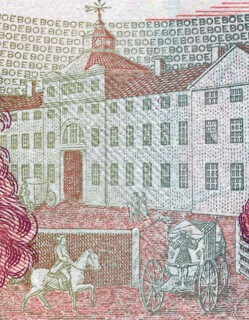What all the world desires
Louis Mackay inspects the new £50 note
When you pay with a fiver, a tenner or even a twenty, the chances are the shop assistant barely gives the banknote a glance. But hand over a fifty-pound note, and its half a ton to a pony that the recipient will make a show of holding it up to the light to make sure it’s genuine. Most people probably only look for the wire and the watermark. The Bank of England lacks complete confidence in these long-established devices, so it now includes many other security features. Without them, counterfeiting would doubtless be a bigger problem than it is: according to the figures for 2009, only one note in every 50,000 in circulation was a fake; 95 per cent of them were twenties. One-pound coins are much easier to forge: about one in 36 of the 30 to 40 million circulating is reckoned to be counterfeit.
The new £50 note was released on 2 November. Few high street banks have yet seen one, but information highlighting the security features was published in advance. Besides the ‘metal thread’ and the watermarks, the high quality printing, the complex patterning and colour modulation, the unique serial number (with numerals in various sizes and colours) and the microtexts, the notes have raised lettering, and a ‘see-through register’ – coloured shapes on each side that, held up to the light, combine to form a £ symbol. A ‘motion thread’ is woven into the paper, on which holographic representations of the £ symbol and the number 50 not only alternate, but appear to move in space.An ultraviolet lamp turns the five ‘window’ sections of this thread green, and makes an otherwise invisible ‘50’ appear in a bright red and green harlequin pattern, along with a random scattering of bright flecks. According to the Parliamentary Office for Science and Technology, the Bank of England is likely to have also included some covert features, which only key Bank personnel can verify: magnetic or even radioactive inks, or special spectroscopic or isotopic characteristics.
The new, reddish-brown note’s design closely matches that of the £20 note. A similar montage of pattern, ornament and pictorial elements is contained in a rectangular panel, with the watermark pushed into a largely blank side-margin. There’s a similar typographic mishmash too. The denominations on the £5 and £10 notes are in large sanserif figures; the £20 and the new £50 have Roman letter forms.
All four current banknotes use the same royal portrait, and are illustrated with historical figures from the 18th and 19th centuries: Elizabeth Fry (£5), Charles Darwin (£10) and Adam Smith(£20) are now joined by the industrial entrepreneur Matthew Boulton and James Watt, shown with one of Watt’s steam engines and the Soho Factory in Birmingham where they were produced. Boulton and Watt also manufactured a coining mill used by the Royal Mint and many other exchequers. Taken as a group, this selection of pioneering figures is clearly intended to represent social, scientific, philosophical, economic and industrial achievements that, 200 years after their time, still – or so it is hoped– reflect credit on Britain.
The microtexts that a magnifier reveals in the new banknote are limited to plodding repetitions of the initials BOE, the £ symbol, the figure 50 and the words ‘Fifty’ and ‘Pounds’. This dullness(compared with the microtextual surprises in the new UK passport) is partly made up for by the quotations associated with the historical figures in the two newer notes. On the twenty, Adam Smith’s words, superimposed on a scene from the early Industrial Revolution, have the form of a heading or caption, but read as an incomplete sentence waiting for its main verb: ‘The division of labour in pin manufacturing (and the great increase in the quantity of work that results)’.
On the new fifty, Boulton and Watt, provided with what might as well be speech bubbles, seem to be talking to each other about their engine – though the gaze of both is fixed firmly on you, the bearer.
‘I sell here, Sir, what all the world desires to have,’ Boulton says. ‘POWER.’
‘I can think of nothing else,’ Watt replies, ‘but this machine.’

Comments
Second only to the Fed.